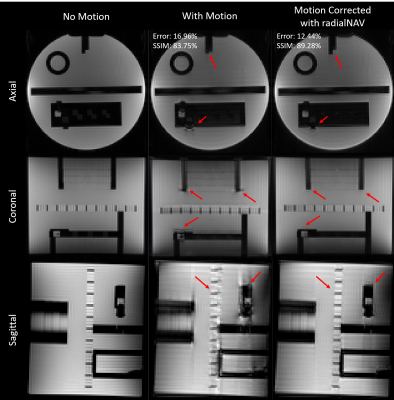Zhe Wu1, Lars Kasper1, and Kamil Uludag1,2,3
1Techna Institute, University Health Network, Toronto, ON, Canada, 2Koerner Scientist in MR Imaging, University Health Network, Toronto, ON, Canada, 3Center for Neuroscience Imaging Research, Institute for Basic Science and Department of Biomedical Engineering, Sungkyunkwan University, Suwon, Korea, Republic of
1Techna Institute, University Health Network, Toronto, ON, Canada, 2Koerner Scientist in MR Imaging, University Health Network, Toronto, ON, Canada, 3Center for Neuroscience Imaging Research, Institute for Basic Science and Department of Biomedical Engineering, Sungkyunkwan University, Suwon, Korea, Republic of
Radial navigator (radNAV) is easy to implement on most kinds of sequences with minimal increase in TE/TR and without the need for non-Cartesian gradients or coil sensitivity extrapolation.

Figure 3 Three slices from axial, coronal and sagittal planes to
demonstrate the motion artifacts and the effect of motion correction using
radNAV. After correction, the least square error reduced from 16.96% to 12.44%
and the structural similarity index (SSIM) increased from 83.75% to 89.28. Red
arrows indicate the motion artifacts before/after the correction.

Figure 1
A: Sequence diagram for turbo-FLASH with radNAV; B and C: k-space trajectories
for one navigator frame. B: sequentially ordered spokes with 15 (black dots) and 30
(red circles) evenly distributed in 3D space as temporal period. C: 15 (black
dots) and 30 (red circles) 3D golden angle spokes. Different spoke number in
each navigator frame for sequential order (B) completely alters k-space trajectory,
while 3D golden angle spokes (C) overlaps given different spoke number,
suggesting a sliding window method is applicable for increasing temporal
resolution of the navigator frame.